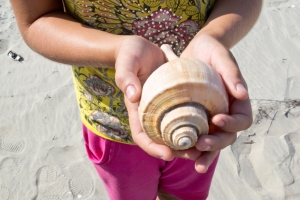(Marine Science Consortium, July 19, 2012) Today began with a trip to Chincoteague to meet Waterman Randy Birch and pick up the bushels of crabs for tonight’s big dinner.
He delivered not only our meal but a lesson in how to identify “the sign,” his code for selecting them at their freshest. It’s when the small fuzzy edge of a blue crab’s swimmerettes, or hind legs, turns from white to pink. These are “peelers,” about to molt, when their meat is full and tasty – marine science at its best!
But there’s lots to do before the crab boil. First, we head to the beach at Wallops Island NASA Base to collect shells with Grant and his team. It’s a beautiful morning, and a great chance to walk and talk, or to find specimens we’ll discuss on the sand before heading back to the lab.
We spend all afternoon identifying and examining the sea creatures we’ve caught earlier in the week, while learning what makes our fish, crabs, shrimp, and sea worms unique. And then, on cue, our sea cucumber slowly constricts itself from head to…well…the other end. It’s a great show.
Our final observation is a microscopic view of the plankton we’ve caught, preceded by a lecture about their true nature. They can be either animal or plant, and the only qualification for plankton status is being unable to swim against the current. Some plankton stay that way forever, while others spend only a part of their lives being planktonic. “Plankton is a lifestyle,” as Grant Melville puts it. And yes, that literary flair marks him as a descendent of the author of Moby Dick. Sadly, only slightly more than half of us know who Herman Melville was.
When dinner is served, we relate to crabs, shrimp, and clams in a more traditional manner, with mallets, cocktail sauce, and drawn butter. Our lab becomes a Road Scholar restaurant, and all of us have a great time eating and talking about our week on Virginia’s Eastern Shore. A talent show featuring young participants and Marine Science Institute interns ends this last full day of our program with music and a hearty share of laughs. And thankfully, there’s another day ahead of us tomorrow.






